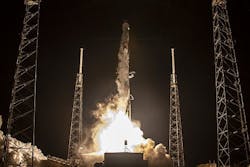SpaceX launches 17th commercial resupply mission and will join five other spacecraft at the ISS
The spacecraft launched on a Falcon 9 rocket from Space Launch Complex 40 at Cape Canaveral Air Force Station in Florida and is scheduled to arrive at the orbiting laboratory on Monday, May 6. Dragon will join five other spacecraft currently at the station.
Dragon's launch comes on the heels of robotics ground controllers in Mission Control Houston successfully completing an operation to remove a failed Main Bus Switching Unit (MBSU) aboard the space station and replace it with a spare. The completion of the robotics work marks the second replacement of an MBSU not involving a spacewalk. The space station continues to be a critical test bed where NASA is pioneering new methods to explore space, from complex robotic work to refueling spacecraft in flight and developing new robotic systems to assist astronauts on the frontier of space. Technologies such as these will be vital as NASA looks to return astronauts to the Moon by 2024.
Expedition 59 astronauts David Saint-Jacques of the Canadian Space Agency and Nick Hague of NASA will use the space station's robotic arm to grapple Dragon around 7 a.m. Coverage of robotic installation to the Earth-facing port of the Harmony module will begin at 9 a.m.
This delivery, SpaceX's 17th cargo flight to the space station under NASA's Commercial Resupply Services contract, will support dozens of new and existing investigations. NASA's research and development work aboard the space station contributes to the agency's deep space exploration plans, including returning astronauts to the Moon's surface in five years.
Ready to make a purchase? Search the Intelligent Aerospace Buyer's Guide for companies, new products, press releases, and videos
